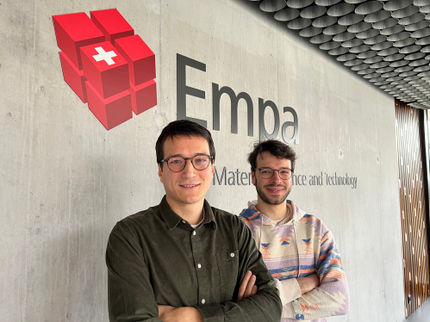Scientists are first to see elements transform at atomic scale
Byproduct of research may lead to new way to irradiate cancer with gold-bonded isotopes
Advertisement
Chemists at Tufts University's School of Arts and Sciences, collaborating with PerkinElmer and UCL (University College London), have witnessed atoms of one chemical element morph into another for the first time ever - a feat that produced an unexpected outcome that could lead to a new way to safely treat cancer with radiation.
The research appears in Nature Materials. Scientists led by E. Charles H. Sykes, Ph.D., a professor of chemistry at Tufts and senior author on the paper, worked with iodine-125 - a radioactive isotope that is routinely used in cancer therapies. Using a scanning tunneling microscope, which can produce images of each atom in a material's surface, they observed individual atoms of iodine-125 decay. As each atom decayed it lost a proton and became tellurium-125, a non-radioactive isotope of the element tellurium.
The transformation of one element to another occurred when the researchers infused a single droplet of water with iodine-125 and deposited it on a thin layer of gold. When the water evaporated, the iodine atoms bonded with the gold. The researchers inserted the tiny sample -- smaller than a dime -- into the microscope.
Iodine-125 atoms have a half-life of 59 days, meaning that at any time, any atom of the radioisotope will decay, giving off vast amounts of energy and becoming the isotope of tellurium, with half of the atoms decaying every 59 days. It was impossible to predict when any one of the trillions of atoms in the sample would transmute into tellurium, so the researchers worked up to 18 hours a day for several weeks so they wouldn't miss the transformations.
Eventually they managed to take scanning tunneling microscope images that showed small atom-sized spots all over the surface. An international collaboration with Angelos Michaelides, Ph.D., a professor of theoretical chemistry at UCL, and Philipp Pedevilla, a doctoral candidate at UCL, helped interpret these images and assign the features as newly formed tellurium atoms.
To verify that they had indeed seen the transformation, they studied one of the samples over several months with an X-ray photoelectron spectrometer to determine its exact chemical makeup. 'By taking the measurement every week or two, we could see the chemical transmutation from one element to another,' as the sample went from mostly iodine to mostly tellurium, says Sykes.
Gold-Plated Cancer Fighters?
Then Alex Pronschinske, Ph.D., first author on the paper and a postdoctoral researcher in Sykes' lab, suggested that they measure the electrons emitted by the sample without prodding from X-rays in the photoelectron spectrometer. He was particularly interested in the emission of low-energy electrons, which have been shown to be very effective in radiation oncology because they break cancer cells' DNA into pieces. Because these electrons can travel only 1 to 2 nanometers they do not affect healthy tissue and organs nearby.
The team calculated the number of low-energy electrons they expected would be emitted by the sample, based partly on data from simulations used by the medical community. They found that the gold-bonded iodine-125 emitted six times as many low-energy electrons as plain iodine-125.
The gold, says Sykes, 'was acting like a reflector and an amplifier. Every surface scientist knows that if you shine any kind of radiation on a metal, you get this big flux of low-energy electrons coming out.'
The finding suggests a new avenue for radiation oncology: make nanoparticles of gold, bond iodine-125 to them, then affix the nanoparticles to antibodies targeting malignant tumors and put them in a liquid that cancer patients could take via a single injection. Theoretically, the nanoparticles would attach to the tumor and emit low-energy electrons, destroying the tumor's DNA. The gold-based nanoparticles would be flushed out of the body, Sykes says, unlike free iodine-125, which can accumulate in the thyroid gland and cause cancer.
If proven, this approach could be a potential improvement over current radiation therapy protocols, in which doctors treat some cancers by putting radioisotopes, including iodine-125, into tiny titanium capsules and implanting them in tumors. Instead of emitting large amounts of low-energy electrons as the gold-bound iodine does, the titanium capsules inhibit radiation, Sykes says, making such therapies less effective than they could be. He has applied for a patent on the new technique.
Researchers in Sykes' lab are now assessing precisely how the low-energy electrons travel through biological fluids.
Other news from the department science
Most read news
More news from our other portals
See the theme worlds for related content
Topic World Spectroscopy
Investigation with spectroscopy gives us unique insights into the composition and structure of materials. From UV-Vis spectroscopy to infrared and Raman spectroscopy to fluorescence and atomic absorption spectroscopy, spectroscopy offers us a wide range of analytical techniques to precisely characterize substances. Immerse yourself in the fascinating world of spectroscopy!

Topic World Spectroscopy
Investigation with spectroscopy gives us unique insights into the composition and structure of materials. From UV-Vis spectroscopy to infrared and Raman spectroscopy to fluorescence and atomic absorption spectroscopy, spectroscopy offers us a wide range of analytical techniques to precisely characterize substances. Immerse yourself in the fascinating world of spectroscopy!























































